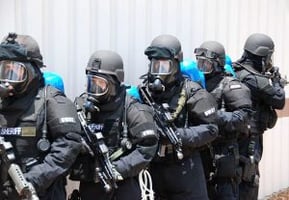Erica Wolfkill, Federal Government & Critical Infrastructure Director
By Dr. Christina Baxter, Emergency Response TIPS, LLC
Post on October 2, 2017
 As the synthetic opioid crisis continues to sweep across our Nation, detection technologies are being enhanced to ensure that they can detect, categorize, and/or identify synthetic opioids. Prior to beginning any detection regime, it is first important to ensure that the responders are properly protected from the material they are detecting. Therefore, using a risk-based approach, ensure that the appropriate protective equipment is employed. The protective posture may include respiratory protection with chemical protective clothing or be as simple as interrogating the sample within a glove box or hood. Once the responders’ safety is managed, the next step in the process is determining the level of material available for detection. Trace detection techniques are required for samples that are less than 1 microgram in available materials, which is usually not viable to the unaided human eye. Trace samples are generally residues on surfaces, outside packages, at interfaces, etc. Bulk detection technologies can only be used with samples that have visible amounts of material to interrogate.
As the synthetic opioid crisis continues to sweep across our Nation, detection technologies are being enhanced to ensure that they can detect, categorize, and/or identify synthetic opioids. Prior to beginning any detection regime, it is first important to ensure that the responders are properly protected from the material they are detecting. Therefore, using a risk-based approach, ensure that the appropriate protective equipment is employed. The protective posture may include respiratory protection with chemical protective clothing or be as simple as interrogating the sample within a glove box or hood. Once the responders’ safety is managed, the next step in the process is determining the level of material available for detection. Trace detection techniques are required for samples that are less than 1 microgram in available materials, which is usually not viable to the unaided human eye. Trace samples are generally residues on surfaces, outside packages, at interfaces, etc. Bulk detection technologies can only be used with samples that have visible amounts of material to interrogate.
Two detection technologies can detect fentanyl and its analogs at trace levels: mass spectrometry and ion mobility spectroscopy. The currently available trace detection products with fentanyl and its analogs in the libraries include the MX908 from 908 Devices, the Griffin 510 from FLIR, and the IONSCAN 600 from Smiths Detection. Of these three products, the MX908 is the only handheld product, weighting 8.7 lbs. The Griffin 510 and the IONSCAN 600 are transportable systems that weigh 36 lbs. and 23 lbs., respectively. All three of these technologies detect and identify mid-nanogram level quantities of the threat materials of interest.
There are two main detection technologies used to detect and identify fentanyl and its analogues at bulk levels: Raman spectroscopy and infrared spectroscopy. Raman Spectroscopy instruments can further be divided into Spatially Offset Raman Spectroscopy (SORS) and standard Raman spectroscopy. The only commercial SORS product is the Resolve from Cobalt Light Systems, a part of Agilent Technologies. SORS provides the unique capability of seeing through opaque and non-opaque containers up to several millimeters in thickness, except for metals, in addition to the standard vial-based and surface detection techniques. The Cobalt Light Resolve is a handheld SORS product that also provides advanced mixture resolution algorithms and a broad 830 nm laser to acquire data points across a broad sample area. Many other Raman systems on the market utilize other laser wavelengths, with the most common being 785 nm and 1064 nm. The 785 nm wavelength provides the higher limits of detection and the 1064 nm wavelength provides less interference from sample fluorescence.
When determining the best Raman system to suit your operational needs, it is imperative that the operator understand the materials contained within the library on the system and the reach-back support provided by the vendor. For drug detection, the most common Raman system is the Thermo Fisher Scientific TruNarc due to its extensive narcotics library and lower cost. Infrared Spectroscopy is another vibrational spectroscopy, like Raman spectroscopy, but it does not have issues with fluorescence and is able to identify strong bases. The sample preparation required to utilize Infrared Spectroscopy is a drawback for field use. The DHS SAVER program evaluated Infrared Spectroscopy technologies in 2016 and found the following systems to be the highest performers: Thermo Fisher Scientific Gemini, Thermo Fisher TruDefender FTX, and the Smiths Detection HazmatID Elite. The Gemini™ received the highest usability rating of all three and has the added capability of integrated Raman Spectroscopy within the same instrument.
The final category of detection technologies for the bulk detection and classification of fentanyl and its analogs is colorimetric chemistries. The only product that is specific to fentanyl versus opioids is the Mistral Fentanyl Reagent Presumptive Drug Test. The DetectaChem SEEKERe, with either the Multi-Detection Kit (MDK) or the Drug Detection Kit (DDK), does not provide specific fentanyl detection, versus opioid/heroin detection, but it provides the user with an automated detection routine.
Dr. Christina Baxter is the CEO of Emergency Response TIPS, LLC which provides practical, evidence-based solutions for emergency response through the development of next generation tools for enhanced situational awareness and responder safety and instructional design materials for instructor-led and web-based programs in the areas of CBRNE, hazardous materials, and clandestine laboratory response.
Federal Resources will continue to keep its users up to date on the changes and work alongside its core partners to provide critical solutions to protect the U.S. Government, military, and first responders.
Want to learn more about the products mentioned in this article?

